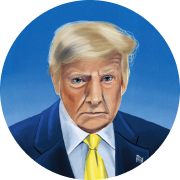Looking to Argentina, the president is willing to risk a recession to see his vision come to pass.
President Donald Trump has basically told Americans to buckle up for a downturn. He has had a lot of opportunities to push back on recession fears. He has not taken them. He did not deny a recession is possible when Fox News asked. Then, he doubled down this week by threatening 50 percent tariffs on Canada and 200 percent tariffs on Europe, as well as telling the nation’s top business leaders that tariffs are a “big win” and “may go up higher.” That wasn’t what (most) people want to hear.
The results have been predictable. The stock market has tanked, Trump’s approval rating is falling, Americans have grown fearful of a big decline, and leaders of small and large companies are spooked. JP Morgan has raised its recession odds to 40 percent. So why is Trump doing this? Why is he intentionally forcing the economy into a sharp slowdown — or even a recession?
Make sense of the latest news and debates with our daily newsletter
On the surface, it’s out of character. Trump has long bragged about the economy and market performance in his first term. Trump economic adviser Kevin Hassett has told colleagues that the president thinks about the U.S. economy like “one of his own children that he’s immensely protective and proud of.”
That’s according to Timothy Fitzgerald, an economist at Texas Tech University who also served in Trump’s first administration. It’s a helpful way to understand Trump’s mindset, in this case a parent taking the “tough love” approach. The president truly does believe other nations have been ripping off the United States for years… It’s one of his most consistent talking points. And he has become convinced tariffs are the best tool to rectify it, even as business leaders and economists warn that path is dangerous and illogical.
Follow Trump’s first 100 Days
Follow
Another key to understanding Trump’s actions is his admiration for Argentine President Javier Milei, who inherited an economic mess and made swift government cuts that helped bring down extreme inflation while also triggering a deep recession. That downturn is already over, setting up Milei to move on to the next, hopefully more pleasant, phase of his agenda.
“The Trump administration is following the Argentine example by moving rapidly. They see it as structured — or formulaic — chaos,” said Joseph Lavorgna, chief economist at SMBC Nikko Securities America, who served in Trump’s first administration.
Trump didn’t inherit an economy in free fall like Milei, but he does face a choice of whether to lead with the bitter or the sweet parts of his policy platform. He’s opted for tariffs and government cuts first, hoping the pain can be blamed on Joe Biden and will soon be forgotten as he pivots to expansionary policies later.
It’s still unclear just how far Trump will go with tariffs and government cuts. April will be a key month. He has promised even more tariffs — on Canada, Mexico, Europe, India and beyond — on April 2.
Two justifications loom large in his thinking about tariffs. One, he believes he needs the revenue to fund his tax cuts, whose costs are looking increasingly daunting. But he’s also signaling his belief that he can use a combination of tariffs and tax cuts to spur a private-sector boom.
The optimistic case for Trump’s vision comes from Wall Street titans such as Cathie Wood, head of Ark Investment Management, who has been telling clients to look through all the chaos in the next six months to a “future where we see productivity driving real GDP growth at an accelerated rate in an exciting way.” Many on Wall Street are still cheering lower taxes paired with government cuts as a much-needed course correction to unlock growth and lower the federal deficit.
But it seems more likely that Trump’s approach will backfire and harm the economy for years to come. Recessions hurt. They have long-lasting effects on people who lose their jobs and often struggle for years to regain financial stability. This downturn will also be accompanied by painfully higher prices because of tariffs. The typical American family is likely to pay at least $1,000 more a year. A lot of Americans in the bottom half of the income distribution will be worse off — even after tax cuts — because their income tax savings won’t be as high as $1,000. Meanwhile, wealthy Americans will greatly benefit.
Trump’s trade war this year could also dethrone America as the world’s leader. The European Union and even Canada are rethinking their long-standing allegiances to the United States. Meanwhile, his immigration restrictions and scientific research reductions will hamper innovation.
And the manufacturing jobs Trump and his team keep talking about, such as furniture-making in North Carolina, aren’t coming back. In the 1990s and 2000s, it was cheaper to make furniture and many other goods abroad because of lower labor costs. Now, the threat is technology. Not as many people are needed to make goods anywhere in the world.
The jobs America needs now are the jobs of the future. There’s a good case to be made that the United States should compete hard against China for high-tech manufacturing — in autos, semiconductor chips, machine learning. As one of America’s top artificial-intelligence executives, Dario Amodei of Anthropic, said this week, “Whoever establishes dominance in [AI] will have military and economic dominance everywhere.”
Trump is fixated on returning to the economy of the 1990s — or even the 1890s. The only thing worse than undergoing a forced recession would be a forced recession that leaves America less competitive.

